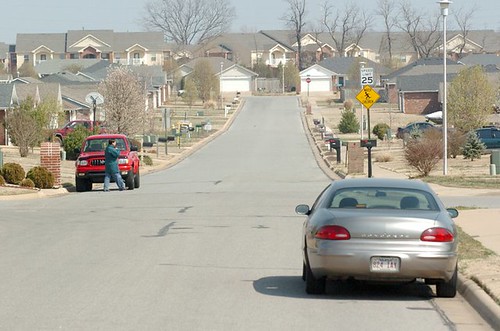
News
By Will Schroeer, July 15, 2009
 |
| Arkansas Wide Street Originally uploaded by Transportation for America |
| An extraordinarily wide street in a pretty typical American subdivision. This street has a 25 mph speed limit, even though it's wide enough to encourage speeds much higher. As a result, residents of neighborhoods like these often end up wanting to install speed bumps or other measures — not quite realizing that the road was designed in such a way to encourage those excessive speeds in the first place. |
The report featured in last Thursday’s Washington Post (“Highway Conditions Contribute to Over Half of Fatal Auto Crashes”) got it half right: highway design does affect safety. But the argument that road and bridge widening is a cure for fatalities is wrong. That recommendation could have been written in 1959, and has been refuted on the ground in projects around the country.
The idea that wider streets are safer appeals to common sense, but stubbornly refuses to show up in actual practice. Instead, statistics show time after time that narrower roads are much safer — for drivers and those who live on those streets. A Colorado study, for example, analyzed 20,000 police accident reports and found accidents per mile per year increased exponentially as road widths increased. The reason is straightforward: wide roads encourage drivers to speed up and pay less attention, which is a recipe for crashes.
As the Post article suggested, the timing of the report is no accident. Congress is taking up a $500 billion transportation bill, and the report’s funders, the Transportation Construction Coalition, are eager to widen roads.
But traffic safety is better served by spending on breakaway signposts, better pavement markings, resurfacing unsafe roads, and rebuilding unsafe bridges. Those are proven to improve safety, and as an extra benefit in this economy, produce more jobs as we showed in our study released two weeks ago, “The States and the Stimulus.”
As they prepare to spend hundreds of billions of dollars in a new transportation bill, Congress and the Administration need all the facts, not just those that support an antiquated, 1950s vision. Both lives and our economy are at stake. The good news is that thoughtful designing for the one also best serves the other.
Related News

© 2026 Smart Growth America. All rights reserved
Site By3Lane Marketing








